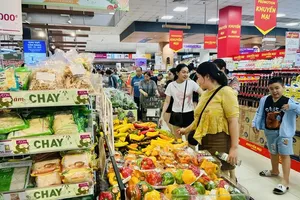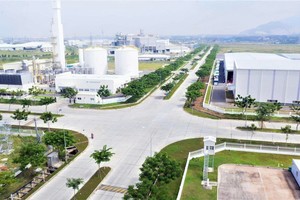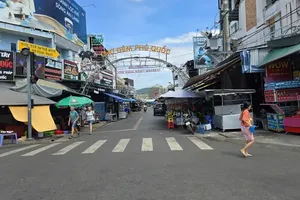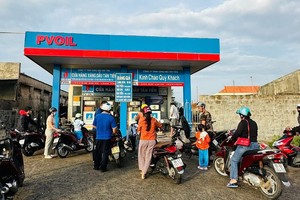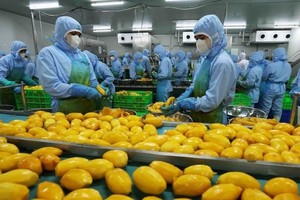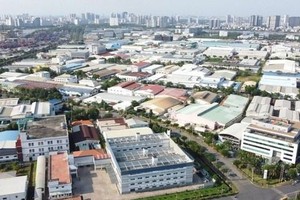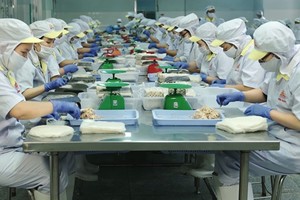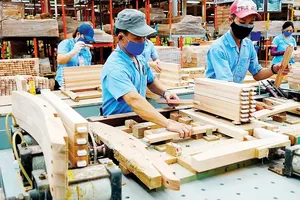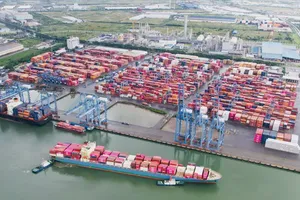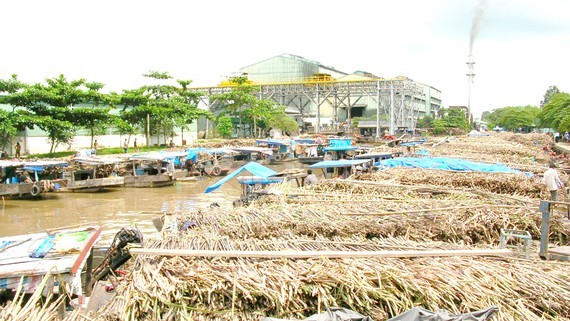
Phung Hiep District in Hau Giang Province has the largest sugarcane area in the Mekong Delta at present, with nearly 5,000 hectares. It is also the place where sugarcane ripens earliest in the region. Huynh Van Cuong, a farmer in Cay Duong Town in Phung Hiep District, has just finished selling 9,000 square meters of sugarcane for VND1,400 per kilogram to traders, earning a profit of more than VND600 per kilogram. This price is considered the highest in the past five years. Cuong said that his family only needed to lend a small boat to the trader to carry sugarcane from the canal to the river and provide drinking water, and the trader took care of other stages themselves. Trader harvested sugarcane many times. However, his family eventually decided to sell 2,000 square meters of sugarcane growing land to grow jackfruit and durian trees. According to Cuong, sugarcane can sell at high prices at the beginning of the crop because traders from Ho Chi Minh and Can Tho cities come to buy sugarcane to resell to sugarcane juice vendors. However, it is also risky because farmers have to find and depend a lot on traders. During the main season, farmers simultaneously harvest sugarcane, so it is ha to find traders of this type. The sentiments of Cuong’s family are also the typical sentiments of the remaining sugarcane farmers in the Phung Hiep District.
According to Tran Van Tuan, Head of the Agriculture and Rural Development Department of Phung Hiep District, currently, farmers in Phung Hiep District have harvested and sold 1,000 hectares out of 4,700 hectares of sugarcane to traders to make sugarcane juice. The area of sugarcane in the Phung Hiep District hit nearly 10,000 hectares at some time. It reduced to 7,000 hectares in 2018, and it is only 4,700 hectares now. The district plans to reduce the area of sugarcane to 3,000 hectares to supply to sugar refineries. About ten years ago, when the prices of sugar ruled the roost in the market, ten sugar factories in the Mekong Delta vied each other to buy material sugarcane. However, the prices of sugar had continuously decreased, causing sugar refineries to suffer losses. Therefore, there are only three sugar refineries left in Hau Giang, Soc Trang, and Tra Vinh provinces, expected to operate as of the end of October this year.
Over the past years, the purchasing prices of raw material sugarcane of sugar refineries have always been low, and farmers have often gained no profit or lost money. According to the calculation of the agricultural sector, the production costs of farmers fluctuate around VND780 per kilogram. Of which, the labor cost for harvesting sugarcane is about VND250 per kilogram, accounting for nearly one-third of the production cost. On October 7, Can Tho Sugarcane Joint Stock Company (Casuco) said that its purchasing price of raw sugarcane was VND820 per kilogram for sugarcane of 10c.c.s., an extremely low price for farmers to make a profit. It also partly explains why Cuong said that by selling sugarcane to sugar refineries, farmers would go bankrupt sooner or later. Many farmers still cling to sugarcane because it is difficult for them to have financial resources to convert the crop.
The leader of a sugar refinery analyzed that with the current wholesale prices of sugar in the market ranging from VND12,000-VND12,500 per kilogram, it is difficult for the factory to buy material sugarcane at above VND900 per kilogram. The remaining factories also face the difficulty that in the past, when the source of sugarcane was plentiful, factories could operate for six months. However, as the area of sugarcane has decreased now, they can only run for three months while having to pay money to retain their workers for nine months without jobs.
Factories only earn a profit of about VND200 per kilogram of sugar at present. A factory with large capacity only gains a profit of VND5 billion, while charter capital is over VND130 billion. The profits from the one-year operation are not equal to interest from bank deposits, a person in the sugar industry said bitterly.
Nearly 20 years ago, not only the Mekong Delta but the whole country also massively imported equipment to build sugar refineries. According to the Vietnam Sugar and Sugarcane Association, there are still nearly 33,000 sugarcane farming households, with about 1.5 million agricultural workers participating in the sugar industry.
As the Ministry of Industry and Trade just decided to initiate an anti-dumping investigation on Thai cane sugar, it has made a slight impact on the market, with the domestic wholesale sugar prices inching up slightly. The probe is currently carrying out based on records from representatives of the domestic sugar industry. For many years, smuggled Thai sugar has been the obsession of domestic sugar refineries. Sugar refineries already know that their survival depends on the sources of raw material sugarcane. Only if the wholesale prices of sugar are profitable can sugarcane be bought at high prices.
According to Tran Van Tuan, Head of the Agriculture and Rural Development Department of Phung Hiep District, currently, farmers in Phung Hiep District have harvested and sold 1,000 hectares out of 4,700 hectares of sugarcane to traders to make sugarcane juice. The area of sugarcane in the Phung Hiep District hit nearly 10,000 hectares at some time. It reduced to 7,000 hectares in 2018, and it is only 4,700 hectares now. The district plans to reduce the area of sugarcane to 3,000 hectares to supply to sugar refineries. About ten years ago, when the prices of sugar ruled the roost in the market, ten sugar factories in the Mekong Delta vied each other to buy material sugarcane. However, the prices of sugar had continuously decreased, causing sugar refineries to suffer losses. Therefore, there are only three sugar refineries left in Hau Giang, Soc Trang, and Tra Vinh provinces, expected to operate as of the end of October this year.
Over the past years, the purchasing prices of raw material sugarcane of sugar refineries have always been low, and farmers have often gained no profit or lost money. According to the calculation of the agricultural sector, the production costs of farmers fluctuate around VND780 per kilogram. Of which, the labor cost for harvesting sugarcane is about VND250 per kilogram, accounting for nearly one-third of the production cost. On October 7, Can Tho Sugarcane Joint Stock Company (Casuco) said that its purchasing price of raw sugarcane was VND820 per kilogram for sugarcane of 10c.c.s., an extremely low price for farmers to make a profit. It also partly explains why Cuong said that by selling sugarcane to sugar refineries, farmers would go bankrupt sooner or later. Many farmers still cling to sugarcane because it is difficult for them to have financial resources to convert the crop.
The leader of a sugar refinery analyzed that with the current wholesale prices of sugar in the market ranging from VND12,000-VND12,500 per kilogram, it is difficult for the factory to buy material sugarcane at above VND900 per kilogram. The remaining factories also face the difficulty that in the past, when the source of sugarcane was plentiful, factories could operate for six months. However, as the area of sugarcane has decreased now, they can only run for three months while having to pay money to retain their workers for nine months without jobs.
Factories only earn a profit of about VND200 per kilogram of sugar at present. A factory with large capacity only gains a profit of VND5 billion, while charter capital is over VND130 billion. The profits from the one-year operation are not equal to interest from bank deposits, a person in the sugar industry said bitterly.
Nearly 20 years ago, not only the Mekong Delta but the whole country also massively imported equipment to build sugar refineries. According to the Vietnam Sugar and Sugarcane Association, there are still nearly 33,000 sugarcane farming households, with about 1.5 million agricultural workers participating in the sugar industry.
As the Ministry of Industry and Trade just decided to initiate an anti-dumping investigation on Thai cane sugar, it has made a slight impact on the market, with the domestic wholesale sugar prices inching up slightly. The probe is currently carrying out based on records from representatives of the domestic sugar industry. For many years, smuggled Thai sugar has been the obsession of domestic sugar refineries. Sugar refineries already know that their survival depends on the sources of raw material sugarcane. Only if the wholesale prices of sugar are profitable can sugarcane be bought at high prices.
